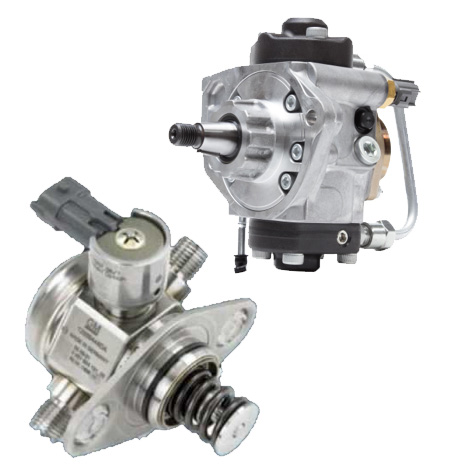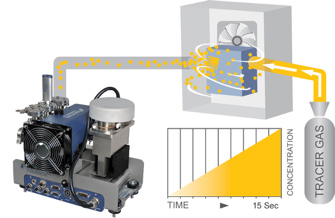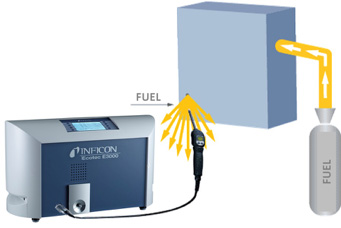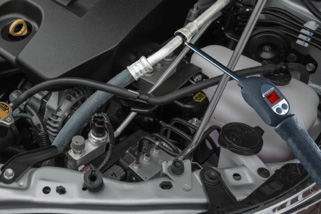TIP:
The Ecotec E3000 leak detector can also be used in the same testing step to check the air conditioning system for leaks by setting it up to detect fuel and refrigerant simultaneously.
Leak Testing of High Pressure Fuel Pumps
Description of Technical Challenge

High pressure fuel pumps need to be tested for leaks to prevent safety risks and loss of engine power.
The need for lower fuel consumption drives the need for high pressure fuel injection. Injection pressures have significantly increased over the past few years. While gasoline fuel injection usually uses pressures up to 300 bar (~ 4500 psi) diesel fuel injection pressures can reach up to 2,500 bar (~ 35,000 psi). Gasoline fuel injection pumps are usually spring driven whereas diesel injection fuel pumps typically use gear drives.
Fuel pump leaks can negatively influence fuel consumption and could cause a fire in the engine compartment. Fuel pump leaks can also result in insufficient fuel pressure resulting in lack of engine power. With increasing fuel injection pressures, larger leak rates will be generated by the same size leak hole.
To prevent leakage, fuel pumps need to be tested for leaks during component production at supplier level. Later in the production process, connections from the fuel pump to the fuel system need to be tested after final assembly. Maximum allowable leak rates usually range in the 5*10-4 ... 5*10-5 mbar l/s range.
The INFICON Solution

Fuel pumps can be tested with low investment in an accumulation system with the LDS3000 AQ leak detector.
Leak testing in component production
Traditionally fuel pumps have been tested in helium vacuum chambers for high reliability leak testing and high throughput.
In recent times, accumulation testing has become more popular as it can offer the same high reliability and high throughput but at significantly lower cost.
For accumulation testing, the fuel pump is evacuated and the evacuation pressure is held for about 2 sec to check for gross leaks. The fuel pump is then backfilled with tracer gas (typically low cost forming gas, i.e. 5% hydrogen in nitrogen, sometimes also helium) to an overpressure of several atmospheres and placed in a simple chamber afterwards. Test gas escaping through any leaks is accumulated in the chamber. Fans ensure an even distribution of the test gas in the chamber – so, independent of the position of the leak, precise measurement values are guaranteed. The LDS3000 AQ leak detector determines the raise in test gas concentration in this atmosphere within several seconds. The rise of concentration is converted into a leak rate by the leak detectors software.

In final assembly, the connections of the high pressure fuel pump to the fuel system are leak tested by sniffing for fuel leaks directly.
Leak testing in final assembly
After final assembly of the fuel system, the connectors from the fuel pump to the fuel system need to be tested. After filling with fuel and running the engine at least once – so that the fuel system is pressurized with fuel – the connections will be checked for leaks by sniffing with the Ecotec E3000 Multi-Gas Leak Detector.
The Ecotec E3000 can detect any gaseous substance selectively including gasoline and diesel. For leak testing, the sniffer tip of the Ecotec 3000 is placed on the connection to be tested. In case of a leak, the escaping gasoline or diesel is transported to the sensor system inside the Ecotec E3000 by the flow through the sniffer line and the leak is detected.

Benefits of Leak Testing Fuel Rails with Tracer Gas
- Accurate and repeatable measurements for reliable results of leak testing
- High throughput testing
- High sensitivity leak testing to find the smallest leaks
- Low energy consumption of component testing system (up to 80% less compared to vacuum chamber system)
- Multi-step process to detect leaks early in the production process
For more information, please visit us at www.inficonautomotive.com